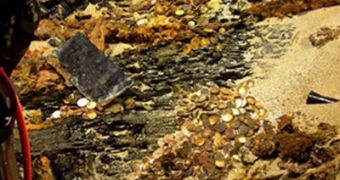The discovery of the greatest sunken treasure ever, estimated at $500 million, has just been announced, and things got heated up. Spain is already investigating whether the treasure was stolen from its waters or from a shipwrecked Spanish galleon, as announced by the Spanish government yesterday.
The treasure was discovered by Odyssey Marine Exploration, a Florida-based treasure-hunting venture, on an undisclosed location in the Atlantic Ocean and is made of 17 tons of gold and silver coins.
Spain's Culture Ministry regards the discovery "suspicious" and the trove could have been found in a wrecked Spanish galleon or even the wreck of HMS Sussex off the coast of Gibraltar, which Spain and Britain permitted Odyssey to investigate.
"Both taking (treasure) from Spanish waters or a Spanish vessel that sunk outside Spanish waters would be illegal. The Culture Ministry reported the suspicion of possible criminal plundering and we alerted the civil guard (police) who are investigating." stated the Ministry.
The 80-cannon British ship Sussex seems to have sunk during a storm in 1694, while on a secret mission to northern Italy, and had to deliver a huge cargo of coins to the Duke of Savoy as a reward for fighting France. It seems that the duke failed to receive the British money and changed sides to France. Odyssey denies that the treasure has any connection with the Sussex and, categorizing this theory as "wild allegations", the Spanish claim that the discovery was made in international waters.
Gibraltar's government did not connect the treasure to the Sussex but the Ministry of Defense personnel in Gibraltar said that an Odyssey ship anchored in Gibraltar's naval dock last week and a chartered American Airlines plane transported the cargo to Tampa, Florida, the headquarters of Odyssey.
In UK, the enigmatic treasure is rather linked to the Merchant Royal which shipwrecked off the southern England in 1641, a hypothesis not commented by Odyssey.
The zone where the discovery was made has always been a crowded shipping route and the trove could come from a Spanish galleon transporting gold and silver to the Spanish Netherlands or even one from the Spanish Armada heading towards England in the war of 1588.
"The wreck bears the characteristics of one shipwreck in particular, but some of the evidence gathered to date is inconsistent with our research." commented Odyssey.
"The fact that coins were brought back to the United States means a challenge to the ownership of that property would have to be heard in a U.S. Court," said Jim Shirley, an attorney specializing in maritime issues for the law firm Holland & Knight.

 14 DAY TRIAL //
14 DAY TRIAL //